Pricing Guides & Dictionary of Makers Marks for Antiques & Collectibles

A few examples of appraisal values for
COWBOY HALL OF FAME
Search our price guide for your own treasures
-
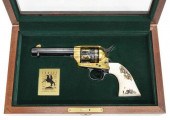 NATIONAL COWBOY HALL OF FAME .45
NATIONAL COWBOY HALL OF FAME .45 REVOLVERNational Cowboy Hall of Fame Uberti Single Action revolver, U.S. Historical Society, .45 caliber, six-round cylinder embellished with western scenes, 5.5" barrel, blued and gilt finish, stag grips, glass top wood framed display box, and owner's manual, excellent condition, never fired, SN 219-SAXXX *REQUIRES FFL TRANSFER* **Provenance: Eight Point Ranch, Elgin, Texas**
NATIONAL COWBOY HALL OF FAME .45
NATIONAL COWBOY HALL OF FAME .45 REVOLVERNational Cowboy Hall of Fame Uberti Single Action revolver, U.S. Historical Society, .45 caliber, six-round cylinder embellished with western scenes, 5.5" barrel, blued and gilt finish, stag grips, glass top wood framed display box, and owner's manual, excellent condition, never fired, SN 219-SAXXX *REQUIRES FFL TRANSFER* **Provenance: Eight Point Ranch, Elgin, Texas** -
 BOB KUHN (1920-2007)The Cougar,
BOB KUHN (1920-2007)The Cougar, 1977 signed "Kuhn" lower left acrylic on illustrator's board, 17 by 25 1/2 in. This painting graced the cover of Fred King's "Sportsman's Edge" Catalog in 1978. Born and raised in Buffalo, New York, Bob Kuhn enjoyed visiting the Buffalo Zoo and sketching its inhabitants as a child. After studying design, anatomy, and life drawing at the Pratt Institute in New York City, Kuhn made his living working as an illustrator for various wildlife and outdoor magazines. Kuhn’s work is featured in the permanent collections of the National Museum of Wildlife Art in Jackson, Wyoming; the National Cowboy Hall of Fame in Oklahoma City, Oklahoma; and the John L. Wehle Gallery of Sporting Art at the Genesee Country Village and Museum in Mumford, New York. A rare opportunity to own one of Kuhn's big cat paintings.
BOB KUHN (1920-2007)The Cougar,
BOB KUHN (1920-2007)The Cougar, 1977 signed "Kuhn" lower left acrylic on illustrator's board, 17 by 25 1/2 in. This painting graced the cover of Fred King's "Sportsman's Edge" Catalog in 1978. Born and raised in Buffalo, New York, Bob Kuhn enjoyed visiting the Buffalo Zoo and sketching its inhabitants as a child. After studying design, anatomy, and life drawing at the Pratt Institute in New York City, Kuhn made his living working as an illustrator for various wildlife and outdoor magazines. Kuhn’s work is featured in the permanent collections of the National Museum of Wildlife Art in Jackson, Wyoming; the National Cowboy Hall of Fame in Oklahoma City, Oklahoma; and the John L. Wehle Gallery of Sporting Art at the Genesee Country Village and Museum in Mumford, New York. A rare opportunity to own one of Kuhn's big cat paintings. -
 BOB KUHN (1920-2007)Close but No
BOB KUHN (1920-2007)Close but No Cigar, 2003 signed and dated "Kuhn 03" lower left acrylic on board, 13 3/4 by 23 1/4 in. Born and raised in Buffalo, New York, Bob Kuhn enjoyed visiting the Buffalo Zoo and sketching its inhabitants as a child. After studying design, anatomy, and life drawing at the Pratt Institute in New York City, Kuhn made his living working as an illustrator for various wildlife and outdoor magazines. In the early 1970s, Kuhn switched to painting full time. Kuhn’s work is featured in the permanent collections of the National Museum of Wildlife Art in Jackson, Wyoming; the National Cowboy Hall of Fame in Oklahoma City, Oklahoma; and the John L. Wehle Gallery of Sporting Art at the Genesee Country Village and Museum in Mumford, New York. Kuhn's most notable works capture the twisting and turning of predators in pursuit of their prey. In this painting, a pouncing bobcat attempts to seize a flying grouse in a snowy, winter landscape. It relates closely to his famous and widely published work "Survival Tactics," depicting the same species. Provenance: Private Collection, Bozeman, Montana Literature: "Wild Harvest: The Animal Art of Bob Kuhn," 1997, p. 85.
BOB KUHN (1920-2007)Close but No
BOB KUHN (1920-2007)Close but No Cigar, 2003 signed and dated "Kuhn 03" lower left acrylic on board, 13 3/4 by 23 1/4 in. Born and raised in Buffalo, New York, Bob Kuhn enjoyed visiting the Buffalo Zoo and sketching its inhabitants as a child. After studying design, anatomy, and life drawing at the Pratt Institute in New York City, Kuhn made his living working as an illustrator for various wildlife and outdoor magazines. In the early 1970s, Kuhn switched to painting full time. Kuhn’s work is featured in the permanent collections of the National Museum of Wildlife Art in Jackson, Wyoming; the National Cowboy Hall of Fame in Oklahoma City, Oklahoma; and the John L. Wehle Gallery of Sporting Art at the Genesee Country Village and Museum in Mumford, New York. Kuhn's most notable works capture the twisting and turning of predators in pursuit of their prey. In this painting, a pouncing bobcat attempts to seize a flying grouse in a snowy, winter landscape. It relates closely to his famous and widely published work "Survival Tactics," depicting the same species. Provenance: Private Collection, Bozeman, Montana Literature: "Wild Harvest: The Animal Art of Bob Kuhn," 1997, p. 85. -
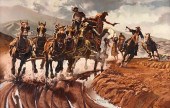 OLEG STAVROWSKY (AMERICAN/TEXAS
OLEG STAVROWSKY (AMERICAN/TEXAS 1927-2020) A PAINTING, ...OLEG STAVROWSKY (American/Texas 1927-2020) A PAINTING, "Attack on Stage," CIRCA 1975, oil on canvas, signed L/R "Oleg Stavrowsky;" 35 3/4" x 56", framed 47 1/2" x 67 1/2". Note: Oleg Stavrowsky was born in New York to immigrant parents from Russia. He spent his early life in military service during the end of WWII. His artistic career and training began doing technical illustrations for McDonnell Douglas Aircraft as well as fashion illustrations for advertising. In 1969 he was in Oklahoma City and visited the Cowboy Hall of Fame and the experience changed his life. He decided to stop doing commercial illustration and to make a go of it as a fine artist capturing the beauty and drama of the American West. He was successful almost from the start and ended up settling near Austin and building a 50 year career painting cowboys, Native Americans and horses set in the rugged splendor of the Western landscape. Stavrowsky was known for his skillful depictions of figures in difficult to capture poses. He achieved this mastery of foreshortening by projecting enlarged photographic images in his studio and using these as guides for his painted compositions. Condition: There are no visible signs of damage or alteration. Simpson Galleries strongly encourages in-person inspection of items by the bidder. Statements by Simpson Galleries regarding the condition of objects are for guidance only and should not be relied upon as statements of fact and do not constitute a representation, warranty, or assumption of liability by Simpson Galleries. All lots offered are sold "AS IS."
OLEG STAVROWSKY (AMERICAN/TEXAS
OLEG STAVROWSKY (AMERICAN/TEXAS 1927-2020) A PAINTING, ...OLEG STAVROWSKY (American/Texas 1927-2020) A PAINTING, "Attack on Stage," CIRCA 1975, oil on canvas, signed L/R "Oleg Stavrowsky;" 35 3/4" x 56", framed 47 1/2" x 67 1/2". Note: Oleg Stavrowsky was born in New York to immigrant parents from Russia. He spent his early life in military service during the end of WWII. His artistic career and training began doing technical illustrations for McDonnell Douglas Aircraft as well as fashion illustrations for advertising. In 1969 he was in Oklahoma City and visited the Cowboy Hall of Fame and the experience changed his life. He decided to stop doing commercial illustration and to make a go of it as a fine artist capturing the beauty and drama of the American West. He was successful almost from the start and ended up settling near Austin and building a 50 year career painting cowboys, Native Americans and horses set in the rugged splendor of the Western landscape. Stavrowsky was known for his skillful depictions of figures in difficult to capture poses. He achieved this mastery of foreshortening by projecting enlarged photographic images in his studio and using these as guides for his painted compositions. Condition: There are no visible signs of damage or alteration. Simpson Galleries strongly encourages in-person inspection of items by the bidder. Statements by Simpson Galleries regarding the condition of objects are for guidance only and should not be relied upon as statements of fact and do not constitute a representation, warranty, or assumption of liability by Simpson Galleries. All lots offered are sold "AS IS." -
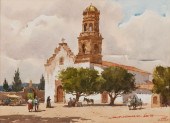 LOWELL ELLSWORTH SMITH (AMERICAN,
LOWELL ELLSWORTH SMITH (AMERICAN, 1924-2008)Lowell Ellsworth Smith American, 1924-2008 Church Near Patzcuaro Watercolor on paper Signed lower right as well as to verso with title. Architectural rendering of a chapel with figures mingling in the road outside, behind plexiglass, gilt frame with label to verso for National Cowboy Hall of Fame; Prix de West Invitational. Acquired June 12th, 1999 from Prix de West Invitational of Oklahoma City, Oklahoma and accompanied by paperwork, bill of sale. Sight: 10 x 14 1/4 in. (25.40 x 36.20 cm.), frame: 19 x 22 1/2 in. (48.26 x 57.15 cm.) The Wallace Estate: Lee Renfrew Wallace and her husband Mahlon Brookings Wallace III lived an extremely happy and luxurious life filled with world travels, safaris, collecting, and philanthropy. From backgrounds in race-horse breeding and championship cattle ranching, the socialite couple paid homage to the St. Louis area community in a variety of ways. Mr. Wallace served as Director of Commerce Bank, President of the St. Louis Zoo Friends Board, and was charitable to numerous organizations he believed in. Behind every great man is a better woman, and his wife Lee was renowned for being the glue of the family while she warmly served as Director of Development for local educational institutions and made an impact with her lasting spirit. The couple’s art collection ranges in style and period and spans a broad price-point.
LOWELL ELLSWORTH SMITH (AMERICAN,
LOWELL ELLSWORTH SMITH (AMERICAN, 1924-2008)Lowell Ellsworth Smith American, 1924-2008 Church Near Patzcuaro Watercolor on paper Signed lower right as well as to verso with title. Architectural rendering of a chapel with figures mingling in the road outside, behind plexiglass, gilt frame with label to verso for National Cowboy Hall of Fame; Prix de West Invitational. Acquired June 12th, 1999 from Prix de West Invitational of Oklahoma City, Oklahoma and accompanied by paperwork, bill of sale. Sight: 10 x 14 1/4 in. (25.40 x 36.20 cm.), frame: 19 x 22 1/2 in. (48.26 x 57.15 cm.) The Wallace Estate: Lee Renfrew Wallace and her husband Mahlon Brookings Wallace III lived an extremely happy and luxurious life filled with world travels, safaris, collecting, and philanthropy. From backgrounds in race-horse breeding and championship cattle ranching, the socialite couple paid homage to the St. Louis area community in a variety of ways. Mr. Wallace served as Director of Commerce Bank, President of the St. Louis Zoo Friends Board, and was charitable to numerous organizations he believed in. Behind every great man is a better woman, and his wife Lee was renowned for being the glue of the family while she warmly served as Director of Development for local educational institutions and made an impact with her lasting spirit. The couple’s art collection ranges in style and period and spans a broad price-point. -
 BILL OWEN (AMERICAN, 1942-2013)Bill
BILL OWEN (AMERICAN, 1942-2013)Bill Owen American, 1942-2013 Desert Cowcamp , 1999 Oil on canvas Signed and dated lower right. One of the largest paintings of Owen's oeuvre, this quiet painting depicts a small band of cowboys at rest under a twilight sky. Backing board with label from National Cowboy Hall of Fame / Prix de West Invitational indicating title. Acquired June 17, 1999 from Altermann & Morris Galleries of Dallas, Texas and accompanied by paperwork. Stretcher: 24 x 48 in. (60.96 x 121.92 cm.), frame: 32 x 56 in. (81.28 x 142.24 cm.) The Wallace Estate: Lee Renfrew Wallace and her husband Mahlon Brookings Wallace III lived an extremely happy and luxurious life filled with world travels, safaris, collecting, and philanthropy. From backgrounds in race-horse breeding and championship cattle ranching, the socialite couple paid homage to the St. Louis area community in a variety of ways. Mr. Wallace served as Director of Commerce Bank, President of the St. Louis Zoo Friends Board, and was charitable to numerous organizations he believed in. Behind every great man is a better woman, and his wife Lee was renowned for being the glue of the family while she warmly served as Director of Development for local educational institutions and made an impact with her lasting spirit. The couple’s art collection ranges in style and period and spans a broad price-point.
BILL OWEN (AMERICAN, 1942-2013)Bill
BILL OWEN (AMERICAN, 1942-2013)Bill Owen American, 1942-2013 Desert Cowcamp , 1999 Oil on canvas Signed and dated lower right. One of the largest paintings of Owen's oeuvre, this quiet painting depicts a small band of cowboys at rest under a twilight sky. Backing board with label from National Cowboy Hall of Fame / Prix de West Invitational indicating title. Acquired June 17, 1999 from Altermann & Morris Galleries of Dallas, Texas and accompanied by paperwork. Stretcher: 24 x 48 in. (60.96 x 121.92 cm.), frame: 32 x 56 in. (81.28 x 142.24 cm.) The Wallace Estate: Lee Renfrew Wallace and her husband Mahlon Brookings Wallace III lived an extremely happy and luxurious life filled with world travels, safaris, collecting, and philanthropy. From backgrounds in race-horse breeding and championship cattle ranching, the socialite couple paid homage to the St. Louis area community in a variety of ways. Mr. Wallace served as Director of Commerce Bank, President of the St. Louis Zoo Friends Board, and was charitable to numerous organizations he believed in. Behind every great man is a better woman, and his wife Lee was renowned for being the glue of the family while she warmly served as Director of Development for local educational institutions and made an impact with her lasting spirit. The couple’s art collection ranges in style and period and spans a broad price-point. -
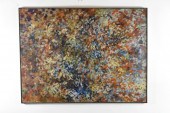 HARRY JACKSON (AMERICAN. B.
HARRY JACKSON (AMERICAN. B. 1924)Rattlesnake Composition, 1972. Signed Jackson 72 l/r. Oil on Canvas. Measuring 40.5 by 30.5 in. (Cond: good) cf. Harry Jackson, was born in Chicago, IL, his birth name was Harry Shapiro. Jackson, a well-known 20th-century artist is best known for his western sculpture, his paintings range in style from Abstract Expressionism to Realism. At age 14, he left home for Wyoming where he worked at a lumber company and on several ranches. The artist often spoke of these years as those that brought him to a spiritual awakening. At the time he believed any talent that he possessed was fostered and reinforced by praise from his cowboy peers. In the late 1930’s, he returned to Chicago and studied at the Frederick Mizen Academy, The Chicago Academy of Fine Arts, and The Chicago Art Institute. Like many of his contemporaries he entered the Armed Forces in 1942 where he was exposed to European painting and the classics. In 1966, he was given the first one-man show at the new National Cowboy Hall of Fame in Oklahoma City. Jackson's work is widely held and includes collections of The Vatican, John Wayne, Buckingham Palace, the Smithsonian and other major US museums.
HARRY JACKSON (AMERICAN. B.
HARRY JACKSON (AMERICAN. B. 1924)Rattlesnake Composition, 1972. Signed Jackson 72 l/r. Oil on Canvas. Measuring 40.5 by 30.5 in. (Cond: good) cf. Harry Jackson, was born in Chicago, IL, his birth name was Harry Shapiro. Jackson, a well-known 20th-century artist is best known for his western sculpture, his paintings range in style from Abstract Expressionism to Realism. At age 14, he left home for Wyoming where he worked at a lumber company and on several ranches. The artist often spoke of these years as those that brought him to a spiritual awakening. At the time he believed any talent that he possessed was fostered and reinforced by praise from his cowboy peers. In the late 1930’s, he returned to Chicago and studied at the Frederick Mizen Academy, The Chicago Academy of Fine Arts, and The Chicago Art Institute. Like many of his contemporaries he entered the Armed Forces in 1942 where he was exposed to European painting and the classics. In 1966, he was given the first one-man show at the new National Cowboy Hall of Fame in Oklahoma City. Jackson's work is widely held and includes collections of The Vatican, John Wayne, Buckingham Palace, the Smithsonian and other major US museums. -
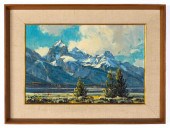 CONRAD SCHWIERING (AMERICAN,
CONRAD SCHWIERING (AMERICAN, 1916–1986), "EVENING MANTLE, JACKSON HOLE, WYOMING" Oil on artist board. Signed Schwiering with monogram (lower left). Conrad Schwiering (American, 1916-1986) Conrad Schwiering, also known as Connie Schwiering, was an American landscape painter from Wyoming. Schwiering became a painter in Jackson Hole, Wyoming in 1947, and he opened a gallery in the Wort Hotel the following year. One of his mentors was Clifford Hansen, who subsequently served as the Governor of Wyoming. Schwiering did paintings of Wyoming landscapes, including the Tetons. He also painted in Carmel-by-the-Sea, California, and in Mexico. Schwiering was a regionalist, a realist, and an impressionist. His work was exhibited at the Cowboy Hall of Fame and the Gilcrease Museum in Oklahoma. Schwiering was a founding member of the National Academy of Western Art, and he appeared in Who's Who in American Art.
CONRAD SCHWIERING (AMERICAN,
CONRAD SCHWIERING (AMERICAN, 1916–1986), "EVENING MANTLE, JACKSON HOLE, WYOMING" Oil on artist board. Signed Schwiering with monogram (lower left). Conrad Schwiering (American, 1916-1986) Conrad Schwiering, also known as Connie Schwiering, was an American landscape painter from Wyoming. Schwiering became a painter in Jackson Hole, Wyoming in 1947, and he opened a gallery in the Wort Hotel the following year. One of his mentors was Clifford Hansen, who subsequently served as the Governor of Wyoming. Schwiering did paintings of Wyoming landscapes, including the Tetons. He also painted in Carmel-by-the-Sea, California, and in Mexico. Schwiering was a regionalist, a realist, and an impressionist. His work was exhibited at the Cowboy Hall of Fame and the Gilcrease Museum in Oklahoma. Schwiering was a founding member of the National Academy of Western Art, and he appeared in Who's Who in American Art. -
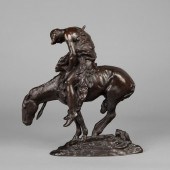 JAMES EARLE FRASER, END OF THE
JAMES EARLE FRASER, END OF THE TRAIL, 1915, 1967James Earle Fraser, (1876 - 1953) End of the Trail, 1915, 1967, bronze, edition 17 inscribed at base: FRASER #17 / SYRACUSE UNIVERSITY The original plasters for these sculptures were bequeathed to Syracuse University by Laura Gardin Fraser, the widow of James Earle Fraser. Her Estate authorized limited castings to be made from these original plasters. James Earle Fraser worked as an assistant to Augustus Saint-Gaudens on the Sherman Monument (1892 - 1903), for the Grand Army Plaza in New York. His sculptural entries in major early twentieth century expositions, such as the 1904 Louisiana Purchase Exposition in St. Louis, the 1915 Panama-Pacific Exposition in San Francisco, and the 1939 New York World's Fair, earned him medals, as well as public and critical acclaim. The design of the Indian head and buffalo nickel for the United States Treasury in 1912, the figure of Theodore Roosevelt on horseback for the entry to the American Museum of Natural History, and numerous other public sculptures, including the Department of the Treasury, the Commerce Building, the National Archives, and the Supreme Court, in Washington D.C., are among the sculptor's most notable public commissions. The sculptor was also one of the organizers of and contributors to the famous, avant-garde International Exhibition of Modern Art, known as the Armory Show, of 1913. Fraser's most acclaimed sculpture neither evokes his European academic training, nor the influence of the East Coast cities where he worked; End of the Trail is a romanticized and nostalgic image of the vanishing West. It is a powerful yet poetic work that is resoundingly clear in its sympathy to the subject matter. While in Paris he had worked on the theme ( the plaster is now lost) and the work was awarded a gold medal in 1910. By the end of 1913, he had cemented his vision of "an Indian on a horse" and the work was accepted for the Pan Pacific exhibition which opened in February 1915 in San Francisco. End of the Trail was awarded the gold medal as the outstanding sculptural work at the fair. This monumental plaster, which measures eighteen feet high, (National Cowboy Hall of Fame, Oklahoma City) was subsequently cast for sites in public parks, in Wisconsin and California. This image was so popular that the artist issued reductions in various sizes and all were cast at the Roman Bronze works foundry. Fraser at his death bequeathed all of his models and archives to the Syracuse University and they were permitted by the Estate to cast posthumous bronzes from the artist's original plasters. bronze, edition 17 Dimensions: 12 1/2 x 3 1/2 x 12 in. (31.8 x 8.9 x 30.5 cm.) Provenance: Comparative
JAMES EARLE FRASER, END OF THE
JAMES EARLE FRASER, END OF THE TRAIL, 1915, 1967James Earle Fraser, (1876 - 1953) End of the Trail, 1915, 1967, bronze, edition 17 inscribed at base: FRASER #17 / SYRACUSE UNIVERSITY The original plasters for these sculptures were bequeathed to Syracuse University by Laura Gardin Fraser, the widow of James Earle Fraser. Her Estate authorized limited castings to be made from these original plasters. James Earle Fraser worked as an assistant to Augustus Saint-Gaudens on the Sherman Monument (1892 - 1903), for the Grand Army Plaza in New York. His sculptural entries in major early twentieth century expositions, such as the 1904 Louisiana Purchase Exposition in St. Louis, the 1915 Panama-Pacific Exposition in San Francisco, and the 1939 New York World's Fair, earned him medals, as well as public and critical acclaim. The design of the Indian head and buffalo nickel for the United States Treasury in 1912, the figure of Theodore Roosevelt on horseback for the entry to the American Museum of Natural History, and numerous other public sculptures, including the Department of the Treasury, the Commerce Building, the National Archives, and the Supreme Court, in Washington D.C., are among the sculptor's most notable public commissions. The sculptor was also one of the organizers of and contributors to the famous, avant-garde International Exhibition of Modern Art, known as the Armory Show, of 1913. Fraser's most acclaimed sculpture neither evokes his European academic training, nor the influence of the East Coast cities where he worked; End of the Trail is a romanticized and nostalgic image of the vanishing West. It is a powerful yet poetic work that is resoundingly clear in its sympathy to the subject matter. While in Paris he had worked on the theme ( the plaster is now lost) and the work was awarded a gold medal in 1910. By the end of 1913, he had cemented his vision of "an Indian on a horse" and the work was accepted for the Pan Pacific exhibition which opened in February 1915 in San Francisco. End of the Trail was awarded the gold medal as the outstanding sculptural work at the fair. This monumental plaster, which measures eighteen feet high, (National Cowboy Hall of Fame, Oklahoma City) was subsequently cast for sites in public parks, in Wisconsin and California. This image was so popular that the artist issued reductions in various sizes and all were cast at the Roman Bronze works foundry. Fraser at his death bequeathed all of his models and archives to the Syracuse University and they were permitted by the Estate to cast posthumous bronzes from the artist's original plasters. bronze, edition 17 Dimensions: 12 1/2 x 3 1/2 x 12 in. (31.8 x 8.9 x 30.5 cm.) Provenance: Comparative -
 SANDY SCOTT, AMERICAN (B.1943),
SANDY SCOTT, AMERICAN (B.1943), CAT, 1995, BRONZE SCULPTURE, 7 1/2"H X 5 1/2"DIAM.Sandy Scott, American, (b.1943) cat, 1995, bronze sculpture signed, numbered 5/50, and dated. Provenance: From a private collector in Zionsville / Indianapolis. From the Archives of AskArt: Born in Dubuque, Iowa, Sandy Scott became one of the foremost animal sculptors in the Southwest in the late 20th century. Her subjects include all kinds of birds as well as domestic and wild animals. At age two, she moved with her family to Tulsa, Oklahoma where she lived until enrolling in the Kansas City Art Institute from 1961 to 1965. She then worked for Calvin Motion Pictures in animation and worked as a flight attendant and also earned her pilot's license. In 1969, she moved to Hawaii and shortly after to San Francisco, where she worked as a portrait artist and illustrator. She also spent much time in wilderness areas, did off-shore sailing, and traveled in Europe. In 1975, she moved to a rural area near Austin, Texas and began doing etchings, making a name for herself with sporting scenes. In 1978, she did a series of rodeo etchings for the National Cowboy Hall of Fame in Oklahoma and had a one-woman show there of more than 60 etchings. That same year, she bought a cabin at Lake of the Woods, Ontario, and in 1982, she completed her first sculpture, which began a new and highly productive phase of her career. In the next two decades she won numerous awards and was voted into prestigious organizations including the Pen and Brush and Northwest Rendezvous Group. In 1987, she bought a former canning factory on ten acres near Fort Collins, Colorado, and from then divided her time between there and her island home at Lake of the Woods in Ontario, Canada. Source: Southwest Art magazine bronze sculpture Dimensions: 7 1/2"H x 5 1/2"Diam.
SANDY SCOTT, AMERICAN (B.1943),
SANDY SCOTT, AMERICAN (B.1943), CAT, 1995, BRONZE SCULPTURE, 7 1/2"H X 5 1/2"DIAM.Sandy Scott, American, (b.1943) cat, 1995, bronze sculpture signed, numbered 5/50, and dated. Provenance: From a private collector in Zionsville / Indianapolis. From the Archives of AskArt: Born in Dubuque, Iowa, Sandy Scott became one of the foremost animal sculptors in the Southwest in the late 20th century. Her subjects include all kinds of birds as well as domestic and wild animals. At age two, she moved with her family to Tulsa, Oklahoma where she lived until enrolling in the Kansas City Art Institute from 1961 to 1965. She then worked for Calvin Motion Pictures in animation and worked as a flight attendant and also earned her pilot's license. In 1969, she moved to Hawaii and shortly after to San Francisco, where she worked as a portrait artist and illustrator. She also spent much time in wilderness areas, did off-shore sailing, and traveled in Europe. In 1975, she moved to a rural area near Austin, Texas and began doing etchings, making a name for herself with sporting scenes. In 1978, she did a series of rodeo etchings for the National Cowboy Hall of Fame in Oklahoma and had a one-woman show there of more than 60 etchings. That same year, she bought a cabin at Lake of the Woods, Ontario, and in 1982, she completed her first sculpture, which began a new and highly productive phase of her career. In the next two decades she won numerous awards and was voted into prestigious organizations including the Pen and Brush and Northwest Rendezvous Group. In 1987, she bought a former canning factory on ten acres near Fort Collins, Colorado, and from then divided her time between there and her island home at Lake of the Woods in Ontario, Canada. Source: Southwest Art magazine bronze sculpture Dimensions: 7 1/2"H x 5 1/2"Diam.
...many more examples with full details are available to our members - Learn more


